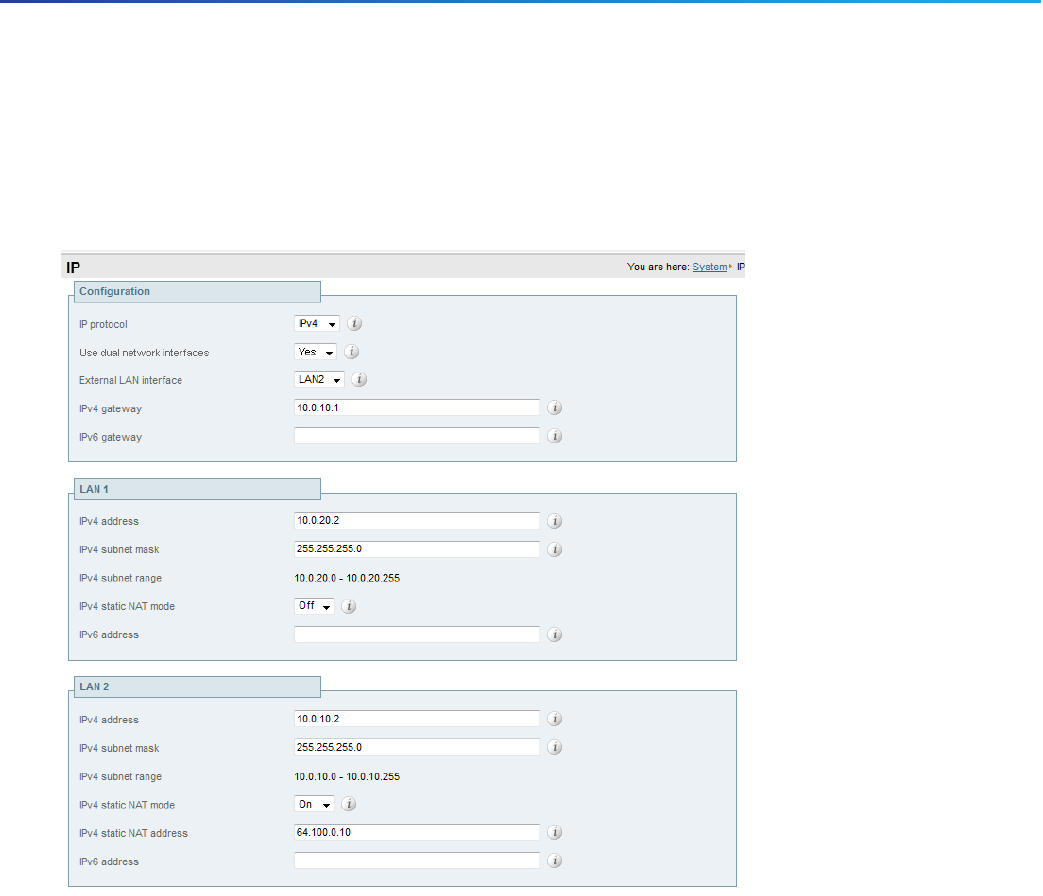Manual
Table Of Contents
- Preface
- Introduction
- Process Summary
- Prerequisites
- Run the Service Setup Wizard
- VCS System Configuration
- Routing Configuration
- Pre-search Transforms
- Search Rules
- Task 8: Configuring Transforms
- Task 9: Configuring Local Zone Search Rules
- Task 10: Configuring the Traversal Zone
- Neighboring Between VCS Clusters
- Task 11: Configuring Traversal Zone Search Rules
- Task 12: Configuring the DNS Zone
- Task 13: Configuring DNS Zone Search Rules
- Task 14: Configuring External (Unknown) IP Address Routing
- Endpoint Registration
- System Checks
- Maintenance Routine
- Optional Configuration Tasks
- Appendix 1: Configuration Details
- Appendix 2: DNS Records
- Appendix 3: Firewall and NAT Settings
- Appendix 4: Advanced Network Deployments
- Obtaining Documentation and Submitting a Service Request
- Cisco Legal Information
- Cisco Trademark

When the Advanced Networking key is installed on the VCS Expressway, the IP configuration page (System >
Network interfaces > IP) has additional options, allowing the user to decide whether to Use dual network
interfaces, to nominate which interface is the External LANinterface, to enable Static NAT mode on selected
interfaces and configure an IPv4 static NAT address for each interface.
Figure 13 VCS Expressway Configuration for the Example Deployment
■ Dual interfaces are selected and the external LAN interface is set to LAN2
■ Configuration > IPv4 gateway is set to 10.0.10.1, the local IP address of the NAT router
■ LAN1 > IPv4 address is set to 10.0.20.2
■ LAN1 > IPv4 static NAT mode is set to Off
■ LAN2 > IPv4 address is set to 10.0.10.2
■ LAN2 > IPv4 static NAT mode is set to On
■ LAN2 > IPv4 static NAT address is set to 64.100.0.10, the public NAT address of the NAT router
When enabling IPv4 static NAT mode on an interface (LAN2 in our example), the VCS Expressway will modify the
payload of H.323 and SIP messages sent out via this interface, so that references to the LAN2 interface address
(10.0.10.2) are replaced with the IPv4 static NAT address configured for this interface (64.100.0.10). This means that
when looking at the payload of SIP and H.323 messages sent out via this interface, it will appear as if the LAN2
interface has a public IP address (64.100.0.10).
It is important to note that the VCS Expressway will not modify the layer 3 source address of outgoing H.323 and SIP
packets sent out of this interface, as this will be done by the NAT router.
With this configuration in place, the SIP INVITE shown in Figure 4 will now look as follows as it arrives at endpoint B:
68
Cisco VCS Expressway and VCS Control - Basic Configuration Deployment Guide
Appendix 4: Advanced Network Deployments










